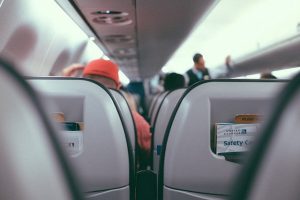 As airplanes ascend higher into the sky, they pump air into the cabin space to pressurize it. All commercial airplanes have pressurized cabins such as this. It doesn’t just create a more comfortable environment for passengers. Rather, cabin pressurization is an important safety feature. So, how does cabin pressurization work, and why is it important for airplanes?
As airplanes ascend higher into the sky, they pump air into the cabin space to pressurize it. All commercial airplanes have pressurized cabins such as this. It doesn’t just create a more comfortable environment for passengers. Rather, cabin pressurization is an important safety feature. So, how does cabin pressurization work, and why is it important for airplanes?
How Airplanes Create Pressurized Cabins
Airplanes pressurize their cabins by pumping air into them. As their jet engines suck in air, some of the excess air is diverted into the airplane’s cabin. The air is both cooled and humidified — meaning moisture is added to it — after which it’s circulated into and throughout the cabin. Once the cabin achieves an ideal pressure level, the airplane will maintain it.
Most airplanes control their cabin pressure via an outflow valve. If an airplane’s cabin exceeds the pressure for which it’s specified, the outflow valve will open. In the open position, excess air will bleed out. The cabin pressure will then drop to an appropriate level, resulting in the outflow valve closing. Some airplanes use other methods to regulate cabin pressure, but most modern-day commercial airplanes rely on an outflow valve for this purpose.
Why Cabin Pressurization Is Important
Cabin pressurization is important because of the nuances between low- and high-altitude air density. Air is less dense at high altitudes than low altitudes. At ground level, the air pressure is a little over 14 pounds per square inch (PSI). When an airplane reaches its typical cruising altitude — usually about 30,000 to 40,000 feet — the air pressure may be just 4 to 5 PSI.
The low air pressure associated with high-altitude flights can restrict passengers from receiving an adequate amount of oxygen unless the cabin is pressurized. Low air pressure means the air is less dense. Therefore, it contains less oxygen. If airplanes didn’t pressurize their cabins, it could lead to insufficient oxygen as well as related medical problems like hypoxia. Airplanes need pressurized cabins because it ensures passengers, as well as crew members, receive an adequate amount of oxygen in the air they breathe.
The good news is that modern-day airplanes are designed with redundancy measures in case of pressurization failure. If an airplane’s cabin loses its pressure, oxygen masks will automatically drop down in front of passengers. Passengers can place one of these oxygen masks over their face to obtain a sufficient amount of oxygen until the airplane descends and lands.



